FAO Fisheries Circular No. 920 FIRM/C920
Rome, 1997
ISSN 0429-9329
REVIEW OF THE STATE OF WORLD FISHERY RESOURCES: MARINE FISHERIES
by
Marine Resources Service,
Fishery Resources Division,
Fisheries Department,
FAO, Rome, Italy
5. MEDITERRANEAN AND BLACK SEA
FAO Statistical Area 37
INTRODUCTION

In this area (Figure B5.1) the Mediterranean system of basins includes semi-enclosed seas ranging from Atlantic water masses in the Western Mediterranean to slightly hypersaline warm-temperate water masses in the Levant basin, hyposaline waters in the Black Sea, and cold-temperate estuarine conditions in the boreal Azov Sea, in total, making up a large number of habitats with diverse stocks and species whose stock trends cannot be individually described here.
The fisheries of the Mediterranean have shown a surprising resistance to high fishing effort compared with, for instance, areas of the Atlantic, especially since formal and coordinated measures for fisheries management are largely absent in most countries.
PROFILE OF CATCHES
Figure B5.2
 The total landings from the area have increased steadily since 1950, reaching
1.95 million tonnes in 1982 and remained around this level until peaking at
1.97 million tonnes in 1988. The subsequent sharp decline to 1.28 million
tonnes in 1991 can mostly be attributed to the collapse of the Black Sea anchovy
and sprat stocks. Other noticeable declines, such as that of the shads and
sturgeons since the mid 1980s, have been caused by degradation in Black Sea
estuarine environments, while the catches of major resources of the Mediterranean
Sea continued to increase throughout this period.
The total landings from the area have increased steadily since 1950, reaching
1.95 million tonnes in 1982 and remained around this level until peaking at
1.97 million tonnes in 1988. The subsequent sharp decline to 1.28 million
tonnes in 1991 can mostly be attributed to the collapse of the Black Sea anchovy
and sprat stocks. Other noticeable declines, such as that of the shads and
sturgeons since the mid 1980s, have been caused by degradation in Black Sea
estuarine environments, while the catches of major resources of the Mediterranean
Sea continued to increase throughout this period.
The Mediterranean Sea is one of the few marine areas of the world's oceans showing a steady increase in production over the entire time series for all major resource categories. This increase in landings is in apparent contrast with a long and active tradition of fishing, large and seasonally increasing coastal populations, and long-standing high demand and prices for locally-caught fish. The strong demand for seafood and the long history of fishing have resulted in heavy fishing intensities over most shelf areas. This high fishing intensity, together with the generally narrow coastal shelves and vulnerability of the resources, would have led one to expect declining catches over most shelf areas, yet this had not occurred. While such characteristics might be interpreted as suggesting that stocks were underexploited in the early part of the time series, a number of dramatic ecological changes have taken place which make this conclusion erroneous. In fact it appears that the increase in production seen in the Mediterranean may represent, more so than for other areas, some index of overall stock changes.
Figure B5.3
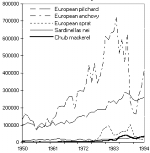 The single major contributor by ISSCAAP Group are the pelagics of Group 35
(Figures B5.2 and B5.3).
From a commercial perspective, in the Mediterranean proper these may be distinguished
into anchovies and others, the former species commanding higher prices and
having shown depletion of stocks in many areas. The second category (sardines,
horse mackerel, sprat, etc.), plus the Black Sea anchovy, have, with local
exceptions, commanded much lower prices and relative declines in market demand
than demersals and invertebrates, the high diversity of which by far dominates
the market value received from the fishery, especially in European markets.
The recent collapse and recovery of anchovy catches in the Black Sea dominates
the landing trend for this species throughout the basin, as does the similar
trend for sprat.
The single major contributor by ISSCAAP Group are the pelagics of Group 35
(Figures B5.2 and B5.3).
From a commercial perspective, in the Mediterranean proper these may be distinguished
into anchovies and others, the former species commanding higher prices and
having shown depletion of stocks in many areas. The second category (sardines,
horse mackerel, sprat, etc.), plus the Black Sea anchovy, have, with local
exceptions, commanded much lower prices and relative declines in market demand
than demersals and invertebrates, the high diversity of which by far dominates
the market value received from the fishery, especially in European markets.
The recent collapse and recovery of anchovy catches in the Black Sea dominates
the landing trend for this species throughout the basin, as does the similar
trend for sprat.
Figure B5.4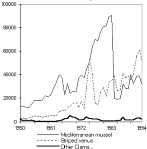 |
Figure B5.5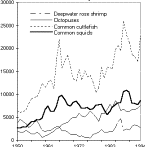 |
Figure B5.6 |
| The high and growing share of invertebrates, especially molluscs, in the catches is noteworthy; particularly clams and blue mussels, as well as catches of octopus, cuttlefish and squids, which reached a plateau after 1988 (Figures B5.4 and B5.5). Among the demersals, hake and red mullet dominate, and have shown rises over the whole time series in most areas, as have a diverse mixture of small demersal fish (Figure B5.6). The collapse of demersal, shellfish and seaweed fisheries in the Black Sea, except for certain local areas, can be seen as a consequence of declines in oxygen levels in bottom water due to eutrophication, especially over the northwest shelf. |
Figure B5.7
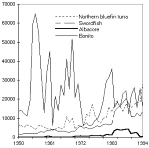 A recent Mediterranean phenomenon has been the dramatic increase in catches
for large pelagics (Figure B5.7), which has been
driven in the case of bluefin tuna by high prices. These high prices have
attracted distant-water fleets as well as new technology, including large-scale
drift nets and long lines also used by some coastal States, despite the ban
of the former gear in international waters. Subsequent declines of some large
pelagic species such as albacore remain unexplained. The lack of catches of
bluefish and bonito in the northern Black Sea since 1970s is probably due
to deteriorated environmental conditions.
A recent Mediterranean phenomenon has been the dramatic increase in catches
for large pelagics (Figure B5.7), which has been
driven in the case of bluefin tuna by high prices. These high prices have
attracted distant-water fleets as well as new technology, including large-scale
drift nets and long lines also used by some coastal States, despite the ban
of the former gear in international waters. Subsequent declines of some large
pelagic species such as albacore remain unexplained. The lack of catches of
bluefish and bonito in the northern Black Sea since 1970s is probably due
to deteriorated environmental conditions.
RESOURCE STATUS AND MANAGEMENT
The apparent anomaly between restricted shelf areas with high trawling intensity and a long-term rise in fisheries production, has prompted a search for major causative factors for the apparent resistance of the ensemble of stocks to the usual effects of heavy fishing. This was reported in previous reviews, in which the effects of nutrient runoff, a phenomenon general to all populated semi-enclosed seas, was highlighted. The hypothesis of nutrient limitation to Mediterranean fisheries ecosystems seems to receive confirmation from historical fishery production per shelf area data which unlike that for almost all other FAO Statistical areas, has continued to slowly increase throughout the time series in the record.
In 1969, production was much below the world average of 3.4 t/km2 of shelf area within 200 nm quoted by J.A. Gulland in 1971, ranging from 2.4-3.4 for the Western Mediterranean closest to the Atlantic inflow, to 0.5-0.6t/km2 for the Ionian, Aegean and Levant, in areas then regarded as among the most nutrient-limited inland seas. By 1989, fishery production figures had increased and varied from 5.25-6.43 t/km2 for the Balearic and Gulf of Lions and 4.78 and 8.15t/km2 for the now eutrophic Black and Marmara Seas. Meanwhile, fishery production in the formerly nutrient-poor areas of the Ionian, Aegean and Levant had risen to 1.42, 2.20 and 1.56t/km2 respectively. Similar trends are shown by demersal and shellfish production, which are of course more closely tied to the shelf area. The Sardinia Statistical Division is the only one to have shown a drop in production per shelf area.
It seems difficult to explain these geographical and temporal changes as a consequence of fishing intensity alone, which was already high in the 1970s. The suggestion is that shelf areas now receive higher levels of nutrients, notably from river runoff in the Northern basins, and that primary production, and its contribution to food webs supporting fishery production, has increased. Dramatic increases in production of plankton and detritus feeders are shown through the sharp rise in Mediterranean mussel, clam and other molluscan production over the last decades. Bottom invertebrates also contribute to food requirements of demersal fish such as the red mullets, soles, grey mullets, seabream and red porgy, all of whose landings have risen steadily over 4 decades (similar increases in landings of gilthead seabream probably in part reflect increased cage culture of this species).
The fact that these fisheries still apparently support high levels of landings in many areas despite high fishing pressure by small mesh trawlers on narrow shelves, is also a subject worthy of further study. Earlier fisheries studies carried out by member countries of the General Fisheries Council for the Mediterranean (GFCM), plus the relatively limited stock assessments performed in the Mediterranean since, suggest that a high fishing pressure has existed, at least in the northern Mediterranean, for several decades. This conclusion appears to be supported by the increased share of short-lived species such as cephalopods, shrimp, and other benthic crustaceans in the landings over the last few decades. Increased recruitment, possibly accompanied by declines in larger predators, may be among the causative factors here.
Landings of some predominantly inshore demersal species such as the red pandora, pouting, silversides (Table V and Figure B5.8) may represent a growing inshore artisanal and sports fishing pressure with improved gear that is still not properly documented.
The serious decline in landings of the extremely valuable red coral and spiny lobster resources from the deeper shelf and slope, and valuable sponges whose stocks in the southern and eastern Mediterranean were decimated by disease in the 1980s may also reflect ecological changes.
The increase in slope fisheries, especially for the blue and red shrimp and hake over the last few decades, should be viewed with a certain degree of apprehension. The traditional fisheries for hake have used small mesh trawls in inshore areas and targeted 0+ to 2-year-old age groups. The fisheries for hake by other gear in deeper waters are now targeting concentrations of mature fish. Increased offshore fisheries on mature fish is cause for concern because a possible explanatory hypothesis for the continued productivity of demersal stocks is that a small proportion of the 0+ to 2-year-old age groups escape from the inshore areas and form a 'refugium' or spawning escapement in offshore waters. This hypothesis appears to receive support from selectivity studies, which suggest that larger fish such as big hake are less available to capture in small mesh trawls than small fish.
It seems that fishery statistics, for all their deficiencies, provide almost the only long-term biological data source for this ecosystem. These statistics are painting a picture of rapid ecological change within the Mediterranean basins that may apply elsewhere in semi-enclosed and coastal seas. Such ecological changes are a result not only of fishing, but of other activities within adjacent land masses, particularly those which influence the runoff of nutrients.
Figure B5.9
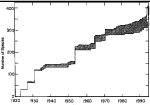 One other dramatic series of ecological changes relating to species introductions
has been mentioned for the Black Sea, where introduction of a number of noxious
species, both phytoplankton and animals, has occurred through cargo ship ballast
water. Possibly, a similar mechanism is responsible for the growing number
of Red Sea species entering the eastern Mediterranean through the Suez Canal
(Lessepian migrants), and subsequently moving northwards and westwards (Figure
B5.9). The dramatic accidental introduction and spread of a toxic species
of seaweed (Caulerpa toxifolia) into the western Mediterranean, is
also likely to affect demersal food chains in that area in a manner which
is not easily predicted.
One other dramatic series of ecological changes relating to species introductions
has been mentioned for the Black Sea, where introduction of a number of noxious
species, both phytoplankton and animals, has occurred through cargo ship ballast
water. Possibly, a similar mechanism is responsible for the growing number
of Red Sea species entering the eastern Mediterranean through the Suez Canal
(Lessepian migrants), and subsequently moving northwards and westwards (Figure
B5.9). The dramatic accidental introduction and spread of a toxic species
of seaweed (Caulerpa toxifolia) into the western Mediterranean, is
also likely to affect demersal food chains in that area in a manner which
is not easily predicted.
The Azov and Black Seas
In the Azov Sea several stock collapses of freshwater fish stocks occurred in the 1960s (pike, bream, roach), and were associated with progressive salination of this habitat due to damming of, and water extraction from, major inflowing rivers: as a result, the salinity of the Azov increased by several parts per thousand. This, plus impacts on spawning routes and spawning areas in the main rivers, has seriously affected natural sturgeon populations, whose catches are now in part maintained by hatchery production. Declines of demersal fish stocks (most importantly turbot), benthic crustaceans, and zoo- and phyto-benthos such as mussels and red algae (which, formerly played a major role, respectively, in filtering and oxygenation of shelf water) occurred in the Northwest Black Sea. These were largely due to anoxic events caused by a greatly increased planktonic production, which, in turn, was linked to nutrient inputs from the large Black Sea catchment basin. Collapses of stocks of the Azov Sea sprat, and in the Black Sea, the anchovy, Mediterranean horse mackerel, and sprat stocks in the late 1980s, were almost certainly linked to the introduction to the Black Sea and Azov of the west Atlantic ctenophore Mnemiopsis leidyi.
Accumulative number of recorded finfish species from the eastern Levant. Shaded area indicates Lessepian migrants from the Red Sea
Top predators such as dolphins have seriously declined in abundance. Predatory fish, including mackerel, blue fish and bonito which used to seasonally enter from the Sea of Marmara (also subject to heavy pollution and fishing), now rarely penetrate into the waters to the north and west of the Black Sea. Stocks of these species can be considered depleted, although (as for a number of other stocks) not necessarily by fishing alone.
Meanwhile, a species of grey mullet (the haarder introduced from the Pacific coast of Russia), a detritus feeder which breeds in shallow water, appears immune to Mnemiopsis predation on its larval stages, and has increased in stock size. Several other introduced species appear pre-adapted to eutrophic conditions, such as the Mya clam and Rapana sea snail, the latter now being a major export item in some countries, and can be considered fully exploited. (See Table B5.1.)
TABLE B5.1: STATUS OF STOCKS OF KEY BLACK SEA FISHERIES
The following general consideration and recommendations have been suggested for serious joint consideration by Black Sea Countries
|
Resource categories |
State of stocks |
Ecological/environmental controls |
Fisheries management measures |
Operational targets |
|
Small pelagic fish
|
Believed that stock size of most small pelagics has partially recovered from Mnemiopsis-caused depletion which began in the early nineties. |
Consider feasibility of keeping Mnemiopsis biomass in check by keeping planktivore biomass high, especially for horse mackerel, believed to be predator on Mnemiopsis.
Important to reduce eutrophication of Black Sea, and hence reduce competitiveness of Mnemiopsis. |
There is an urgent need to decide on a common method of control of fleet size and catch and decide on access, national allocations of catches and fishing opportunities. |
In the absence of a fully operational Black Sea Fisheries Commission, the countries of the region should seek to agree on stock assessments and allocations.
They should meet annually to discuss coordinated plans for fishing and for research surveys.
A system of arbitration of disputes will be required. |
|
Sprat |
Have remained high, especially in NW Black Sea. |
As above. |
Could allow some moderate expansion of fisheries for human food. |
See above considerations for use of fish for food and licence limitation.
Agreement on level of catch should be made between national authorities after cooperative acoustic survey and annual meeting of assessment scientists.
Assistance with regular fishery survey activities of national fleets. |
|
Whiting |
Ditto. |
Careful to avoid over-fishing of a key prey species for predators such as turbot. |
Ditto (by-catch in sprat fishery as well as directed fisheries). |
Ditto. |
|
Anchovy |
Some stock recovery, but restricted by uncontrolled exploitation. (Evidence of some profound changes in age at maturity and area of spawning as a result of Mnemiopsis). |
As for general comments. |
Negotiate internationally and introduce catch or trip limits on national level. |
Ditto. (Aim at increasing stock size and reduce exploitation rate to achieve age composition comparable to early eighties, with more older fish in the stock).
Training of fisheries assessment and management personnel. |
|
Horse mackerel |
Some recovery? |
Predator on Mnemiopsis? |
Allow only incidental catches. |
Ditto. Aim at doubling stock size by 2005. |
|
Resource categories |
State of stocks |
Ecological/environmental controls |
Fisheries management measures |
Operational targets |
|
Turbot |
Declining to seriously depleted levels. |
Environmental conditions of shelf waters restrict stock recovery. |
Essential to decide on national fishing zones. |
An agreement on joint policing of fishing management measures for turbot should be approached. |
|
Priority to recreational/hook-and-line fisheries. Consider banning in most areas of trawls and gill nets. |
Consider feasibility of closed fishing areas where young fish are predominant. (Feasibility study and advice on management of fishery closed areas, location and policing in each country.) |
|||
|
Spiny dogfish |
Slow decline in stocks in most areas. |
Species relatively immune to Mnemiopsis. |
Fishing effort not to exceed current levels.
Take into account migrations in allocating catches. |
A regular coordination of fishing plans between the countries concerned is strongly recommended. (Advice on preparing a coordinated fishery management plan for a �pilot resource� is proposed for this species, involving national and international consultants and one meeting). Aim at doubling biomass by 2000 through appropriate joint management measures. |
Perhaps the most dramatic change in the last few years has been the partial recovery of the anchovy stock, which has occurred in part due to the decline of fisheries in the North and West of the Black Sea. This recovery was partly due to the inability of fleets to fish in the formerly important grounds in the northeast of the Black Sea now within Georgian waters, and probably due to the change in target for the fishery towards waters in the southern Black Sea and to 0+ age groups. In combination, a major selection pressure has been exerted on this stock, which is showing impressive signs of adaptation of anchovy to the exotic planktonic predator mentioned above.
Despite the anchovy collapse and partial recovery, it would be misleading to consider this stock underexploited. Except for the fleets of the former socialist countries, which are undergoing an uncertain process of reconstruction hampered by shortage of funds for repair and investment, the former excessive levels of overcapitalization of the fishing industry mentioned in the last review still exist in the southern Black Sea. By contrast, the stocks of sprat and several other species in the Northern Black Sea may now be underexploited for reasons suggested earlier. The remaining demersal resources should be allowed to rebuild where possible, requiring serious management measures to be adopted by the countries involved.
The reduction of fertilizer use within the huge Black Sea catchment area in the years following movement to a market economy on the part of countries in transition may also have played a part in the recent gradual improvement in water quality of inflowing water from the Danube river.
The Mediterranean
Steep increases of catches of planktivorous species all seem to imply dramatic ecological changes over the last decade. These species include: sardines, especially in the northern Mediterranean; sardinellas in the south; new fisheries for the largely pelagic blotched picarel registered in Tunisia and for bogue, and for near-shore stocks of silversides in the eastern Mediterranean. These changes are not all due to increased fishing pressure but are almost certainly in part due to increased nutrient inputs to a formerly low nutrient sea, as implied by remote sensing imagery, showing high chlorophyll concentrations in the northern Mediterranean. Most of these small pelagic species show wide fluctuations in abundance, and few examples of a species showing steady levels of landings are evident in the Mediterranean data base of landings. Other than anchovy, which has high value and has declined in a number of areas, most small pelagics can be considered moderately to underexploited, due to a generally low market demand.
Steep increases in the catches of predators on small pelagic fish species such as the mackerels, dolphin fish, carangids, amberjack, chub mackerel and swordfish over the last two decades certainly reflect a greater interest in offshore resources, many of which are probably now approaching full exploitation. This increase may also be a consequence of increased food availability of forage fish, as mentioned above, and does not necessarily imply that they were formerly being fished at rates below those that would correspond to full exploitation under stable ecological conditions. Similar increases in landings, (and similar conclusions) apply to demersal predators such as hake, anglerfish, whiting, conger eel and some Dentex stocks, and for a number of these stocks assessments confirm a general state of full exploitation.
Concern has rightly been expressed about the stock status of bluefin tuna and swordfish. In both cases the (apparently unrestrained) growth of surface gill net and long line fisheries over the last decade has increased vulnerability of these stocks as has regular fishing by non-coastal States on bluefin stocks. The bluefin tunas, which are regarded as belonging to a common stock in the eastern Atlantic and Mediterranean, are seriously depleted with respect to the earlier historical record. For this latter species, the GFCM has adopted recently the regulations on bluefin fisheries from the International Commission for the Conservation of Atlantic Tunas (ICCAT), to apply to all member countries of GFCM for swordfish and bluefin tunas. In the case of swordfish, as noted, steady increases in landings may reflect in part increased availability of pelagic forage species but also surely reflect a seriously high level of exploitation, also reflected in progressive decreases in mean size and age at capture.
Some pelagic resources which have not reacted positively to fishing or ecological changes over the last few years are the little tunny, Mediterranean horse mackerel and scombrid stocks. The stocks of a number of important elasmobranch species have collapsed, testifying to the fragility now generally recognized for these low fecundity resources.